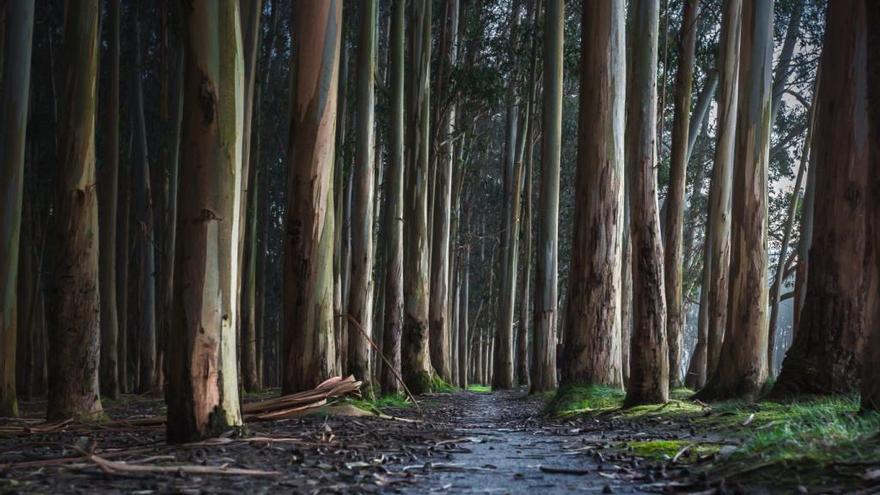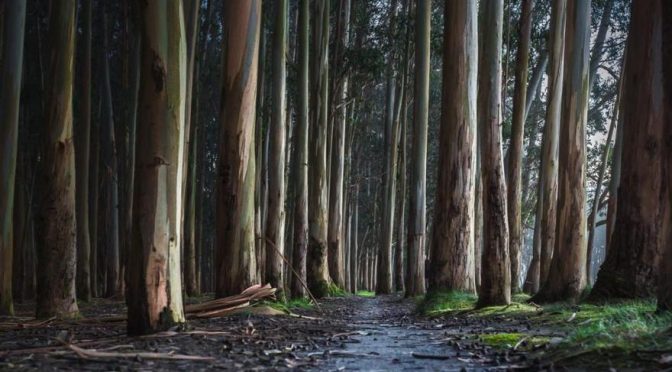On the way down from Mount Oiz, as we took the back road that passed by Goikoetxebarri – my dad’s childhood home – Jon Zuazo told us about how the pine trees of the surrounding forests were dying and how eucalyptus had been recruited to replace it. However, because eucalyptus can be so hard on the surrounding lands, the government of Bizkaia is imposing a moratorium on planting new eucalyptus trees. How did things get so bad?

- There is no doubt that eucalyptus is an economically profitable tree crop. Native primarily to Australia, it grows quickly – 13-15 years to cutting, compared to 35 for pine, 100 for beech, and 130 for oak. Its wood has a number of uses, from ornamentation and firewood to being used as fence posts and to help prevent erosion. It is also used in the extraction of biofuels. Because of all of these factors, it is the most widely grown tree in plantations. However, their fast growth comes at a cost – they consume a great deal of water.
- In the Basque Country, eucalyptus has been seen as a replacement for the pine trees that are being killed by brown band disease (“banda marrón” in Spanish, not sure if this is brown spot needle blight or Dothistroma needle blight). Compounded by drops in lumber prices, the Basque forest industry saw eucalyptus as a viable path toward economic profitability. As of March, 2021, eucalyptus covered 3.5% of the Basque Autonomous Community (Bizkaia, Gipuzkoa, and Araba), up by 5 times in the last 35 years. Much of the expansion in eucalyptus has occurred in Bizkaia, which has some 20,000 hectares of the trees. In some places, 50% of the trees have been replaced by eucalyptus.
- However, eucalyptus has many down sides for the local environment. It releases biochemical compounds that are harmful to other plants and to animals. It soaks up lots of water, further compounding the effect on other plants. All of this impacts biodiversity. For example, the amphibian population has fallen by 50%. There are also fewer birds and insects in regions with eucalyptus.
- On April 13, 2022, the government of Bizkaia passed a moratorium on the planting of new eucalyptus trees until 2026. The goal is to develop a long term and sustainable forestry plan for the province.
- The pines that are being replaced by eucalyptus are, themselves, not native to the Basque Country. The native forests contained oak, beech (the Iraty forest is the largest beech forest in Europe), birch, and ash trees, amongst others, including apple. There is a story that the man my mom’s grandparents worked for in Ispaster, who owned a palace there, gained his wealth by introducing pines to the Basque Country. (It was Mario Adán de Yarza of Ispaster who first planted these trees on his land in 1857.) These were radiata pine, native to California, and now representing 33% of the forests in the Basque Country. When the pine was introduced, the Basque forests had been decimated by overuse and the pines brought new life to them. Further, because its lifecycle is only 30 years to maturity, it proved profitable for the baserritarak who called it “green gold.”
Primary sources: Eucalipto, un árbol maldito para nuestros bosques y ríos by Mikel Zubimendi, Naiz; La restauración de los bosques autóctonos del País Vasco, LandK; «El pino radiata llegó a denominarse ‘oro verde’ por su gran rentabilidad» by Miguel Villameriel, El Diario Vasco; El pino radiata en la historia forestal vasca by Mario Michel.
Discover more from Buber's Basque Page
Subscribe to get the latest posts sent to your email.



Surprisingly you didn’t mention the flammability of the eucalyptus tree. It is a very dangerous tree especially when we are having summers that are so hot & dry.
I didn’t realize that part. Thanks for sharing Drew. That is a critically important point.
Greetings,
Good for them!!!! not to mention that pines and eucalyptus are highly flammable!! We saw the results last year and this year as well with all the wild fine in France and Spain.
The same thing happened to Portugal ten years ago.
Monique
I didn’t know about that part. Thanks for sharing.